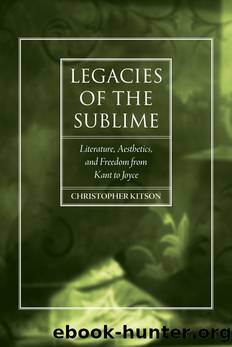Legacies of the Sublime by Kitson Christopher;

Author:Kitson, Christopher;
Language: eng
Format: epub
Publisher: State University of New York Press
Published: 2019-07-14T16:00:00+00:00
Schopenhauer and Kant’s Sublime
This comparison brings into focus Schopenhauer’s post-Kantian development of the sublime. The precise nature of this development is beset by something of an ambivalence concerning Schopenhauer’s relationship to his predecessor’s theory. Sandra Shapshay points out that Schopenhauer both praises and dismisses Kant’s account of the sublime in different texts (Shapshay 479–80). There is nonetheless an identifiable thread of Schopenhauer’s commentary on the sublime at play in The Secret Agent’s treatment of aesthetic objects. This is apparent when considering particularly Schopenhauer’s difference with Kant concerning the sublime’s relation to the beautiful. Schopenhauer maintains Kant’s distinctions between the beautiful and the sublime, as well as that between the mathematical and dynamic sublime. However, he gives an importantly different account of the nature of the beautiful-sublime distinction. Kant holds the beautiful and the sublime to refer to different kinds of entities—that is, the beautiful describes the quality of objects in the world fit to stimulate the free play of our faculties, whereas the sublime may be properly attributed only to aspects of human thought (CJ 160). For Schopenhauer, however, the sublime and beautiful are distinct but continuous. He claims that it is only a “special modification” of the beautiful that distinguishes the two (WWR 1: 208). In addition, Kant’s description of the sublime is attended by a careful delineation of the psychological processes that culminate in the negative presentation of an idea of reason (CJ 137–38). This is not the case for Schopenhauer. In this instance he is scathing of Kant’s “Analytic,” stating that “we differ from him entirely on the inner nature of that impression, and can concede no share in this either to moral reflection or to hypostases from scholastic philosophy” (WWR 1: 205). Schopenhauer replaces Kant’s account with a simplified relation to the phenomenal will:
The difference between the beautiful and the sublime depends on whether the state of pure, will-less knowing, presupposed and demanded by any aesthetic contemplation, appears of itself, without opposition, by the mere disappearance of the will from consciousness, since the object invites and attracts us to it; or whether this state is reached by free, conscious exaltation above the will, to which the contemplated object itself has an unfavourable, hostile relation, a relation that would do away with contemplation if we gave ourselves up to it. (1: 208–9)
The account that emerges in Schopenhauer’s response to the Kantian sublime, then, is one that puts much greater emphasis on the relation of an object to the individual will as the defining feature of the sublime. Schopenhauer is Kantian in that he maintains the staging of an agonistic relationship between the object and the subject, requiring that the object be considered as a potential threat to the subject. In fact, Schopenhauer follows and is more explicit than Schiller in making this relationship both necessary and sufficient for the sublime, where in Kant it was one aspect of a multifaceted distinction between the sublime and beautiful. It is only this that distinguishes the sublime from the beautiful for Schopenhauer.
Download
This site does not store any files on its server. We only index and link to content provided by other sites. Please contact the content providers to delete copyright contents if any and email us, we'll remove relevant links or contents immediately.
Still Me by Jojo Moyes(10790)
On the Yard (New York Review Books Classics) by Braly Malcolm(5395)
Eleanor Oliphant Is Completely Fine by Gail Honeyman(5086)
A Year in the Merde by Stephen Clarke(5080)
The Bookshop by Penelope Fitzgerald(3621)
Surprise Me by Kinsella Sophie(2994)
How Music Works by David Byrne(2965)
Pharaoh by Wilbur Smith(2882)
Why I Write by George Orwell(2775)
A Column of Fire by Ken Follett(2492)
The Beach by Alex Garland(2431)
The Songlines by Bruce Chatwin(2414)
Churchill by Paul Johnson(2368)
Aubrey–Maturin 02 - [1803-04] - Post Captain by Patrick O'Brian(2214)
Heartless by Mary Balogh(2170)
Elizabeth by Philippa Jones(2078)
Hitler by Ian Kershaw(2048)
Harry Potter and the Cursed Child by J. K. Rowling & John Tiffany & Jack Thorne(1974)
The Patrick Melrose Novels by Edward St. Aubyn(1910)
